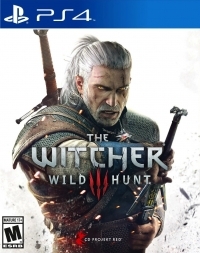Existing User Log In
New User Registration
Register for a free account to gain full access to the VGChartz Network and join our thriving community.





America - Front


America - Back

The problem, as always, when reviewing a huge open-world RPG of such magnificent depth as The Witcher 3: The Wild Hunt is less how to start but how to end; will you exhaust the game or will the game exhaust you? Size does not equal depth after all - a game can have an enormous amount of size and activity, yet possess the depth of a puddle. It is not just important to be able to be do something, but to be able to do something worthwhile.
In The Witcher 3, everything is worthwhile. This is perhaps the most extraordinary aspect of a most extraordinary game. In a genre plagued by quests or activities that are there for the sake of it, Wild Hunt allows even the most innocuous of side-quests to quickly turn into sprawls of decision, consequence, and horror. This isn’t a pleasure left to one or two important diversions; each side-quest is interesting, and deals with a diaspora of human tragedy.
The cause and effect of this human tragedy is the spiralling war engulfing the Northern Realms, dragging rival factions into a mixture of guerrilla warfare, set-piece battles, and forced servitude. Through this world of king-making and political subterfuge wanders Geralt of Rivia, desperately seeking his ward Ciri as the Wild Hunt (a band of wraith-like spirits of utter terror) pursues her. The Wild Hunt chases Ciri, but Geralt himself is no less brutal in his pursuit. Who, indeed, is really on a wild hunt?
The answer to that question may lie in the decisions made by the player. Most confrontations or discussions allow for peaceful, violent, or provocative outcomes – or the murky grey-area where most decisions lie. Thankfully, Wild Hunt does not patronise in these situations or offer a colour-coded ‘blue good/red bad’ morality system. It allows you to read the situation, understand the language, and judge the tone of the response. These decisions have an impact on the way much of the game plays out; a character spared may offer aid later, while people subjected to cruelty will cower as you pass, hostile to your presence. Perhaps you might notice a citizen you refused to help strung from the scaffolding, her weeping family clutching her clammy leg. Perhaps not.
This, like much of Wild Hunt, is left to you. The main quest weaves through the high court and squalid swamps as Geralt takes in a huge variety of landscapes. Again, the key is in the detail. From the lush White Orchard to imposing Novigard, these are not just empty environments, they are filled with life, activity, and adventure. Traders request items, citizens beg for help, commanders pithily request the slaughter of monsters or men, depending on the needs of the city. The universe is so well formed - a brew of folk myth and historical precedent - that everything appears plausible and rightly in its place.
This is a credit not just to the source material but the impeccable pacing and design, aided by excellent script writing. You want to hurt and/or help, even with an awareness of the greater problems such an action may cause. That said, one of the greatest pleasures of The Witcher 3 is just to explore the rolling, rollicking landscape – take in the people, the monsters, the ruins and hills. Like the detail of the side-quests, it is not landscape for landscape’s sake; each carefully cut area is embodied by the spirit, or lack thereof, of the people who inhabit it.
Graphically, Wild Hunt is truly sumptuous; characters are clean and precise, well-animated, with only the occasional frozen stutter associated with digital animation. Clothing is beautifully detailed, layered, and textured. Landscapes are beautiful, with faded horizons emphasised by the sharper detail of thick forests, all of which can be explored. Cities loom, hedged in by close walls and the inexorable dirt of the urban sprawl. Wild Hunt certainly has the best graphics available to be seen on the PS4. There are instances of slow-down and some minor pop-up, but this not surprising for a game of such scope, nor is it unheard of in large open-world games.
Seasoned Witchers, however, may find The Witcher 3 overly forgiving when it comes to combat. The Witcher 2, at times, was brutally hard, requiring a mixture of strategy and patience. Wild Hunt, however, is easier and more accessible in comparison. Although one could not quite hack and slash through the entire game, you might be able to get close to the end before needing a careful stock of potions.
Magical Signs return, somewhat dulled down in power, but potions have been massively expanded. Potions are key to good strategy; being well stocked, with a methodology for combat depending on the opponent, can make all the difference when the harder fights eventually come. These are in the form of huge, imaginative, screen-filling monsters of devastating power.
Battles of attrition, these set-piece moments are fantastic, emphasising the brutal power of a Witcher as a social subset; admired, feared and hated for their prowess. The life of a Witcher is a lonely one, but Geralt’s interactions with his fiercest enemies and most endearing loves are consistent, well-pitched, and clever. You care for each of them – that they live, that they die – and you care for Geralt, a flawed man who happens to wield unbelievable power and therefore influence. It helps that the game is very well acted, backed by a troubling score that grips and grinds as you play what can be an immensely troubling game.
The Witcher 3: Wild Hunt is a tremendous achievement, one that may be lessened or heightened by what follows in the future. For now, it is the high point for narrative-driven open-world RPGs. It has everything, with very little to show in detriment. The narrative is stirring, characters affecting, visuals gorgeous, combat brutal, world riveting, score soaring. It has heart, soul and brutality, a little tenderness but little positivity – for who could be positive in such a scenario? This review barely scrapes the surface, but I’ve probably barely scratched the surface of what Wild Hunt has to offer. That adventure, the excitement of discovery, is best left to you.